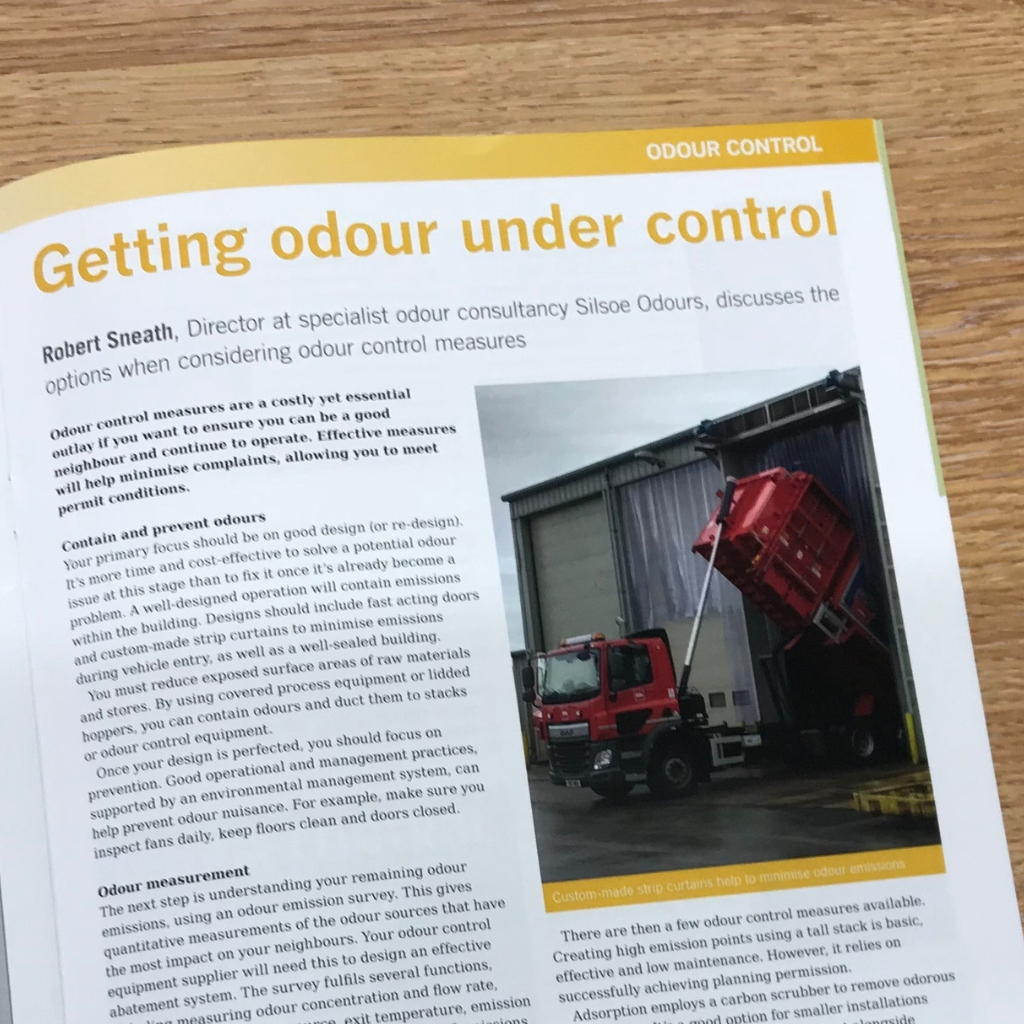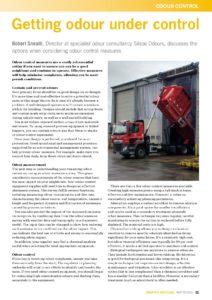“Getting Odour Under Control” – Robert Sneath Contributes to Organics Recycling

The Winter 2018 issue of Organics Recycling landed on our desk this morning! So we’re pleased to share the feature article “Getting Odour Under Control”. Notably, Silsoe Odours Director Robert Sneath wrote the article. In the light of his extensive odour experience, Robert was invited to contribute the introduction for the ‘Odour Control’ buying guide. Specifically, he discusses the various options when considering odour control measures.
Getting Odour Under Control
Odour control measures are a costly yet essential outlay if you want to ensure you can be a good neighbour and continue to operate. Effective measures will help minimise complaints, allowing you to meet permit conditions.
Contain and prevent odours
Your primary focus should be on good design (or re-design). It’s more time and cost-effective to solve a potential odour issue at this stage than to fix it once it’s already become a
problem. A well-designed operation will contain emissions within the building. Designs should include fast acting doors and custom-made strip curtains to minimise emissions
during vehicle entry, as well as a well-sealed building.
You must reduce exposed surface areas of raw materials and stores. By using covered process equipment or lidded hoppers, you can contain odours and duct them to stacks
or odour control equipment.
Once your design is perfected, you should focus on prevention. Good operational and management practices, supported by an environmental management system, can help prevent odour nuisance. For example, make sure you inspect fans daily, keep floors clean and doors closed.
Odour measurement
The next step is understanding your remaining odour emissions, using an odour emission survey. This gives quantitative measurements of the odour sources that have
the most impact on your neighbours. Your odour control equipment supplier will need this to design an effective abatement system. The survey fulfils several functions,
including measuring odour concentration and flow rate, characterising the odour source, exit temperature, emission height and frequency, duration and fluctuation of emissions
caused by process variations.
You can also predict the impact of the measured emission on receptors, by combining data from the odour emission survey with weather data and topography in a dispersion
model. The input data can be changed to show how reducing each emission in turn will reduce the odour impact. This can indicate the best use of efforts and money in successfully
reducing odour impact.
In addition, your supplier may find a chemical analysis useful when selecting the most appropriate equipment.
Odour control
If you begin receiving odour complaints, ensure you take them seriously from the start. The regulator or planning authority will want to see efforts to identify and resolve the
issue. If you need odour control equipment, you should begin by containing high concentration odours and ducting them separately to the equipment.
There are then a few odour control measures available. Creating high emission points using a tall stack is basic, effective and low maintenance. However, it relies on successfully achieving planning permission.
Adsorption employs a carbon scrubber to remove odorous components. It’s a good option for smaller installations and can be used as a secondary treatment alongside other measures. This technique requires regular, careful monitoring to ensure the carbon is replaced before fully depleted. The material costs are high.
Chemical scrubbing allows you to design a chemical reaction to remove specific odorants identified as being significant for your installation. It’s a relatively high cost, but odour removal efficiency can typically be 90 per cent effective. It needs a skilled operator to maintain and control.
Biological techniques use microbes to remove odorants. They include bio-filtration and bio-scrubbing. Bio-filtration is good for biological processes like composting. It’s a simple technique but requires correct design, effective maintenance and irrigation. A bio-scrubber is an effective option that is less complicated than a chemical scrubber and has a smaller footprint than a biofilter. However, a secondary treatment (such as adsorption) is often needed.
More About Odour Control Measures
It is of course a pleasure for Robert to contribute his expertise in such an acclaimed publication. He will undoubtedly be doing so again in the future. In the meantime however, if you are interested in hearing more about odour control measures, then by all means please do get in touch. Robert or one of the team will certainly be glad to clarify your odour queries.

